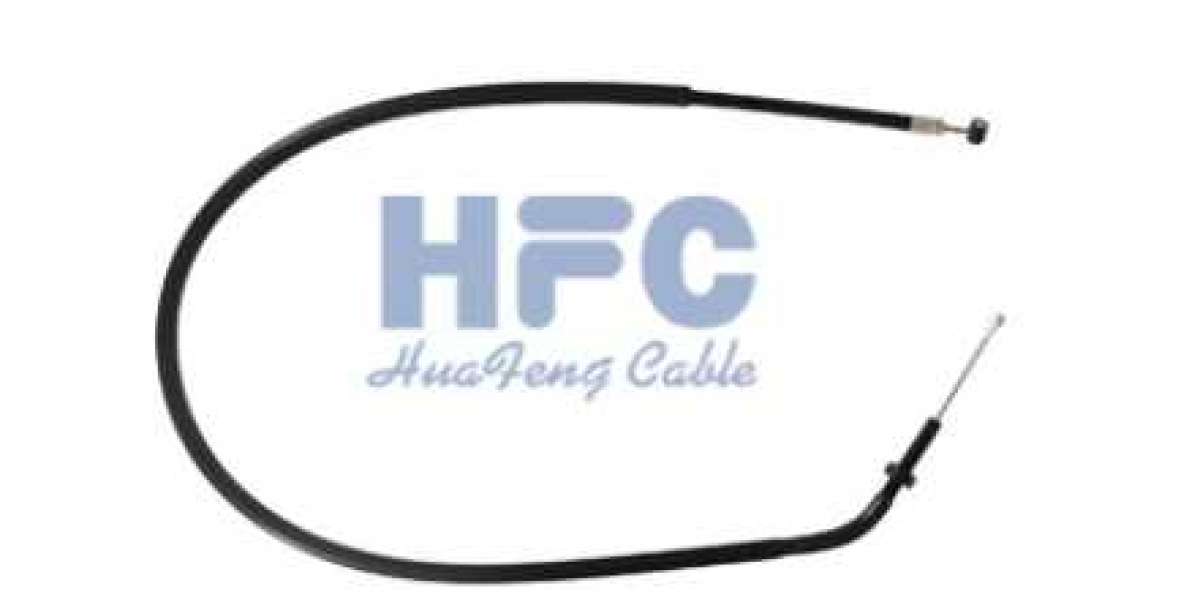A broken clutch cable not only renders your motorcycle or car useless, but it also puts you at risk for an accident and expensive repairs. That's why it's important to know how to prevent your clutch cable from breaking.
In this blog post, we’ll take a closer look at clutches and take a closer look at signs of wear that can lead to cable failure. We'll explore the most common reasons behind these frustrating accidents and provide proactive maintenance tips so you can keep your ride smooth without any unexpected problems. Plus, if all else fails, we'll walk you through the process of replacing a damaged clutch cable.
Understanding the Importance of a Clutch Cable
The clutch cable may seem like a small and insignificant component of your vehicle, but it plays a crucial role in the smooth operation of your clutch system. Think of it as the bridge between your hand and the clutch itself, allowing you to engage and disengage gears with precision.
Without a properly functioning clutch cable, shifting gears becomes an arduous task. It enables you to easily switch between different speeds and control the power transfer from the engine to the wheels. In other words, it's what gives you that seamless transition between gears.
But that's not all! The clutch cable also acts as a safety mechanism. When you press down on the clutch pedal, it releases tension on the cable, which in turn separates the plates inside your transmission. This prevents any unnecessary strain or damage to both your engine and gearbox.
Simply put, without a well-maintained clutch cable, your ability to control acceleration and deceleration is compromised. It can lead to jerky gear changes, excessive wear on transmission components, reduced fuel efficiency - not exactly ideal for optimal driving performance!
Now that we've established just how integral this little cable is let's move onto identifying some red flags that might indicate when it's time for some much-needed attention or replacement.

Signs of a Faulty Clutch Cable
1. Difficulty in Engaging Gears
If you're having trouble shifting gears, it could be due to a stretched or broken clutch cable. You may notice that the gear lever feels stiff or unresponsive when trying to shift, which can be frustrating and even dangerous while driving.
2. Frequent Stalling
A worn-out clutch cable can lead to issues with disengaging gears, making it difficult for your vehicle to come to a complete stop without stalling. This poses a significant safety risk, especially if you're stuck in traffic or navigating through busy roads.
3. Slipping Gears
Another common sign of a failing clutch cable is slipping gears. When the cable is damaged, it affects the tension needed for proper gear engagement, causing your vehicle to slip out of gear and suddenly lose power.
4. Spongy Clutch Pedal
If your clutch pedal feels loose or spongy when pressed, it's likely due to a stretched or broken clutch cable. The pedal should always feel firm and responsive when engaged; otherwise, it's time for some maintenance work.
5. Visible Damage on Cable
Lastly, if you visually inspect the clutch cable and notice any fraying, kinks, or breakage, it's a clear indication that it needs to be replaced. Over time, the cable can wear out due to constant use and exposure to heat and friction.
In conclusion, the clutch cable may be small, but its role in your vehicle's performance is significant. Regular maintenance and prompt replacement when needed are crucial for smooth gear changes and safe driving. If you notice any of the above signs, make sure to get your clutch cable inspected by a professional mechanic.

Signs of a Worn or Damaged Clutch Cable
One of the key components in your vehicle’s clutch system is the clutch cable. It plays a crucial role in connecting the clutch pedal to the release fork, allowing you to smoothly engage and disengage the clutch. Over time, however, this essential cable can become worn or damaged, leading to potential issues with your vehicle's performance.
One sign that your clutch cable may be wearing out is difficulty shifting gears. If you find it increasingly challenging to shift smoothly between gears or notice a grinding noise when changing gears, it could indicate a problem with your clutch cable. Another common symptom is a loose or spongy feeling when pressing down on the clutch pedal. This can be caused by stretched or frayed cables that are no longer providing proper tension.
Another indication of a worn or damaged clutch cable is increased resistance when depressing the pedal. You may notice that it takes more effort than usual to engage and disengage the clutch fully. In some cases, you might even experience complete failure of the clutch system if there is severe damage to the cable.
It's important not to ignore these warning signs as they can lead to further damage and potentially leave you stranded on the side of the road. Regular inspections and maintenance checks are vital for identifying any issues before they escalate into costly repairs.
In our next blog section, we will explore common causes of clutch cable breakage and provide proactive maintenance tips to prevent such breakages from occurring in order for you avoid inconvenience and costly repairs associated with broken cables.
Common Causes of Clutch Cable Breakage
When it comes to clutch cable breakage, there are several common causes that can lead to this frustrating issue. Understanding these causes can help you take proactive steps to prevent your clutch cable from breaking prematurely.
One of the main culprits behind clutch cable breakage is excessive wear and tear. Over time, the constant friction and movement during gear changes can cause the cable to weaken and eventually snap. This is especially true if the clutch pedal is not fully released when shifting gears, putting unnecessary strain on the cable.
Another factor that contributes to clutch cable breakage is improper adjustment. If the cable is too tight or too loose, it can put undue stress on certain parts of the system, leading to premature failure. Regularly checking and adjusting your clutch cable's tension can go a long way in preventing breakages.
Furthermore, environmental factors play a role in clutch cable health as well. Exposure to extreme temperatures or harsh conditions such as dust, dirt, and moisture can accelerate corrosion and deterioration of the cables. Inspecting and cleaning your cables regularly will help mitigate these effects.
In some cases, poor quality or worn-out components may also contribute to premature clutch cable failure. Using subpar materials during replacement or neglecting routine maintenance could result in weakened cables that are prone to snapping under pressure.
By understanding these common causes of clutch cable breakage, you'll be better equipped to prevent them from happening in the first place. Regular maintenance checks along with proper adjustment techniques will keep your clutch functioning smoothly for longer durations without any unexpected setbacks.

Proactive Maintenance Tips to Prevent Breakage
Regular maintenance is key in preventing clutch cable breakage and ensuring smooth operation of your vehicle. Here are some proactive tips to keep your clutch cable in good condition:
1. Lubricate the Cable: Apply a high-quality lubricant specifically designed for cables to reduce friction and wear. Regularly inspect the cable for signs of dryness or corrosion, and apply lubrication as needed.
2. Adjust Cable Tension: Proper tension ensures optimal performance and prevents excessive strain on the cable. Consult your vehicle's manual for instructions on how to adjust the tension, or seek professional assistance if you're unsure.
3. Inspect Mounting Points: Check the mounting points where the clutch cable connects to both ends – at the pedal assembly and at the transmission bell housing. Look out for any signs of damage, such as loose bolts or worn-out bushings, and address them promptly.
4. Avoid Overloading: Excessive force on the clutch system can lead to premature wear and breakage of components like the clutch cable. Be mindful of driving habits that put unnecessary strain on this system, such as riding the clutch or towing heavy loads beyond recommended capacity.
5. Keep It Clean: Dirt, debris, and moisture can accelerate wear on a clutch cable over time. Regularly clean these areas using a soft brush or cloth, paying attention to remove any buildup around moving parts.
Remember that prevention is always better than dealing with a broken clutch cable when it's inconvenient. By following these proactive maintenance tips consistently, you can extend its lifespan and enjoy smoother shifting in your vehicle without unexpected breakdowns!
How to Replace a Broken Clutch Cable
Replacing a broken clutch cable may seem like a daunting task, but with the right tools and steps, you can get your vehicle back up and running smoothly in no time. Here's a guide on how to replace a broken clutch cable:
1. Gather the necessary tools: Before starting the replacement process, make sure you have all the tools required for the job. This typically includes wrenches, pliers, socket set, and possibly some lubricant.
2. Locate and access the clutch cable: The clutch cable is usually connected to the pedal inside your vehicle and runs down to the transmission. Accessing it may require removing some panels or parts of your vehicle's interior.
3. Disconnect old cable: Start by loosening any clamps or connectors that hold the old clutch cable in place. Once loose, disconnect it from both ends - at the pedal assembly inside your vehicle and at the transmission.
4. Install new cable: Take your new clutch cable and carefully thread it through any necessary pathways or guides until it reaches its proper connection points - at both ends.
5. Reconnect everything: Once you've installed the new cable in its proper place, reconnect it to both ends - ensuring that all connections are secure.
6. Test functionality: After installing and reconnecting everything properly, test out your newly replaced clutch cable by pressing on the pedal to ensure smooth operation without any binding or slipping.
Always consult your vehicle's manual for specific instructions regarding replacing a clutch cable as each model may have slight variations in their setup. If you're unsure about tackling this task yourself, don't hesitate to seek professional assistance from an experienced mechanic.

Conclusion
Maintaining your clutch cable is critical to ensuring your vehicle's clutch system operates smoothly and efficiently. By understanding the importance of your clutch cable, recognizing signs of wear or damage, addressing common causes of breakage, and implementing proactive maintenance tips, you can significantly reduce the risk of your clutch cable breaking.
Regularly checking the condition of your clutch cable and addressing any issues promptly is key to preventing breakage. Watch for signs of stiffness or resistance when pressing the clutch pedal, difficulty shifting, or unusual noises from the clutch area. If you notice any of these symptoms, it may be time to replace your worn or damaged clutch cable.
Wuxi Huafeng Motor Vehicle Parts Co., Ltd. mainly deals in various types of control cables, which are widely used in motorcycles, automobiles, agricultural machinery, gardening machinery and other fields. If you need to know more about clutch cable details or order wholesale, welcome to contact us.
Email:hfc@huafengqp.com








